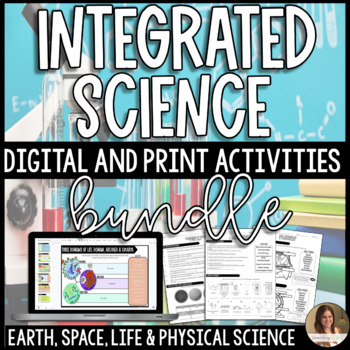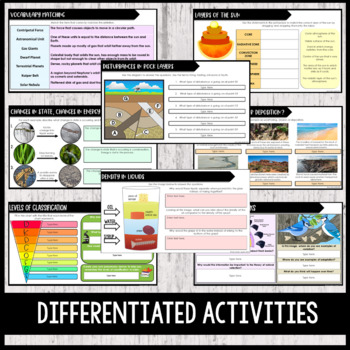Earth Space, Life and Physical Science Activities Bundle Google Slides™ & Print
- Zip
- Google Apps™

Products in this Bundle (39)
showing 1-5 of 39 products
Description
This bundle contains print and digital interactive science notebook resources that use Google Slides for middle school science. There are 6-10 interactive activities in each resource to review middle school science topics in Earth/Space, Life Science, and Physical Science.
Use these activities for:
- Sub Plans
- Test Prep (Florida SSA, Texas STAAR, NGSS)
- Online Learning
- Homework
- Independent review
- Stations
- Interactive Notebook Activity
Students will practice vocabulary skills, make real-world connections and review concepts.
The activities include either drag and drop or short answer text. Watch the preview videos to get a better idea of how each resource works,
The slides and print versions are not editable. An answer key is included in all of the PDF files as well as the Google Slides links.
Content covered:
⭐ Scientific Investigations and Inquiry
⭐ Atoms and the Atomic Theory
⭐ Changes in States of Matter
⭐ Pure Substances and Mixtures
⭐ Periodic Table of Elements
⭐ Physical and Chemical Changes
⭐ Forces and Newton's Laws of Motion
⭐ Energy Forms and Transformations
⭐ Mass, Volume and Density
⭐ Thermal Energy and Heat
⭐ Interactions of Light Waves
⭐ Properties of Waves
⭐ Electromagnetic Spectrum
⭐ Rock Cycle
⭐ Weathering, Erosion and Deposition
⭐ Earth's Atmosphere
⭐ Earth's Layers
⭐ Interactions of Earth's Spheres
⭐ Plate Tectonics and Continental Drift
⭐ The Water Cycle
⭐ Earthquakes and Volcanoes
⭐ Weather
⭐ Climate
⭐ Earth's History: Geologic Time Scale
⭐ Human Impact on Earth and Conservation
⭐ Properties of Stars and the Sun
⭐ The Solar System
⭐ The Earth Moon Sun System
⭐ Levels of Organization
⭐ Cell Theory and Cell Characteristics
⭐ Cell Organelles and Homeostasis
⭐ Classification of Organisms
⭐ Human Body Systems and Homeostasis
⭐ Evolution and Natural Selection
⭐ Mitosis and Meiosis
⭐ Asexual and Sexual Reproduction
⭐ Energy Transfer in Ecosystems
⭐ Interactions of Living Things
⭐ Introduction to Ecology and Succession
⭐ Heredity and Punnett Squares
⭐ Cellular Respiration and Photosynthesis





